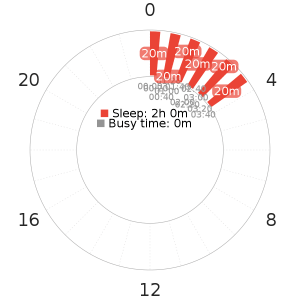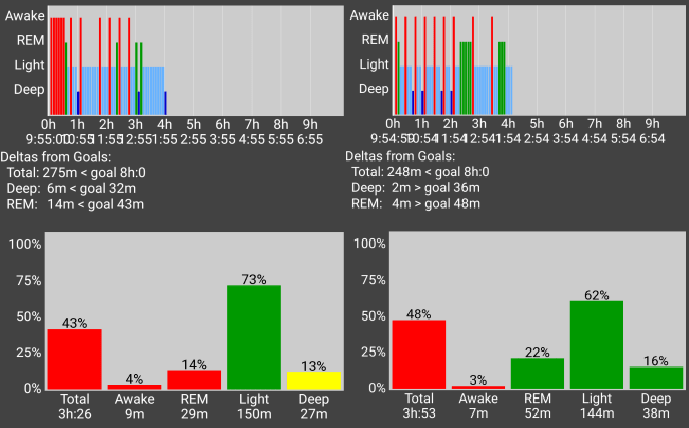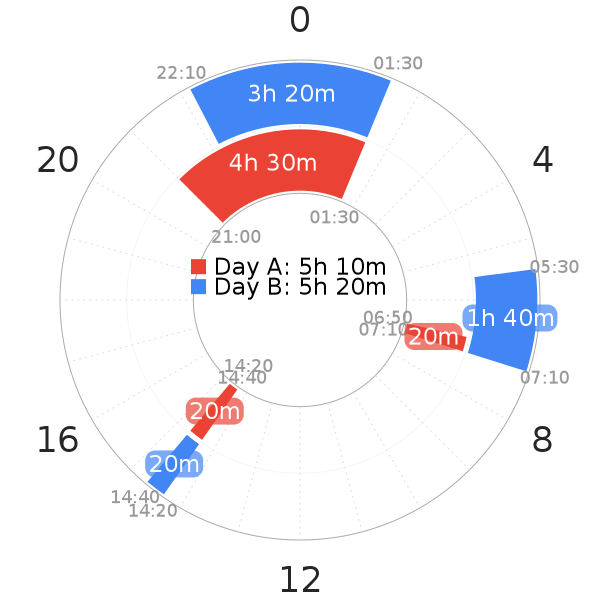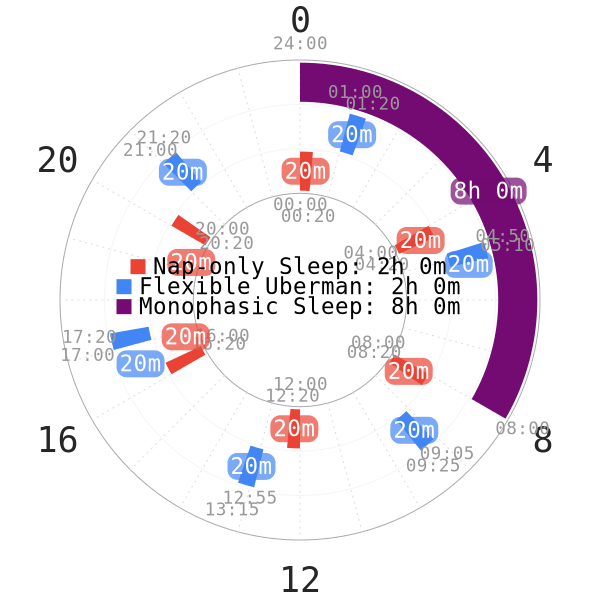A word of warning
Warning! These bad sleep schedules are not recommended; thus, do not think of them as any type of suggestions. The only reason we choose these unadvisable schedules from a surplus of bad ones is because these have been honestly attempted and failed.
Because they go directly against recommendations made on this guide, they showcase a visualization of which fundamental rules they ignore. Again, you should NOT attempt any of the schedules in this post; they will most likely lead to failure!
Introduction
We pick the following bad sleep schedules to show which integral parts of scheduling they have ignored. This also provides you the opportunity to catch information that you might otherwise have missed or misunderstood. Therefore, make sure to review the reasons given why these schedules do not work.
Please note that some people may have adapted to certain variations of these schedules. However, the difficulty would clearly be a lot higher than the standard versions. Additionally, there is no telling that you would actually succeed at all.
Zoidberg

- Proposed by: Dr. Zoid
- Total sleep: 2 hours
- Classification: Nap-only schedule
- Specification: 6 naps
- Mechanics: 6 naps with 20 minute long gaps of wakefulness between them
- Ignoring fundamental rule: staying awake for at least 1, preferably 2 BRACs between sleeps
Premise of creation
The basis of Zoidberg revolves around the idea that you can interchangeably nap for 20 minutes, stay awake for 20 minutes, then rinse and repeat. It allows you to stack these sections on next to each other, resulting in so called “z-cores”.
- In essence, It is a nap-only schedule like SPAMAYL; however, instead of spacing naps apart and throughout the day, they are all adjacent at night.
- Zoidberg also allows adding another nap if necessary to the z-core(s), or during the day.
- It attempts to capitalize on the high sleep quality from sleep onset REM or SWS that often occurs with well-spaced naps by repeatedly triggering the sleep-onset REM and SWS. Thus, the end result would be large totals of restorative sleep.
Problems
The reality is completely the opposite of those wishful theories and adaptation fails for multiple reasons. Two people who attempted the schedule for a few months never got close to adapting, even though they temporarily thought it was working.
- During adaptation stage 1, waking up and going to sleep is a non-problem.
- Falling asleep for the later naps becomes hard, because of the wakefulness sustaining from the earlier naps.
- The naps consist mostly of light sleep due to the brain considering the whole z-core to be one interrupted sleep block. This leads to failure to trigger sleep onset REM or SWS during the interrupted points, or for a majority of the naps.
- Every interruption in sleep also requires an additional amount of light sleep to serve as a transitional phase from waking back into sleep, further reducing time available for SWS or REM.
- Zoidberg is basically just sleeping a single, interrupted cycle a day.
- The percentage of light sleep is extremely high in this demonstration of what effect this bad sleep schedule has on sleep. Refer to the picture below, which displays two days of forcefully interrupting a core.

Implications for other bad sleep schedules
Scheduling sleep blocks too close together will lead to exactly the same thing happening on other schedules. The schedule is not even viable short-term; this is because the humongous sleep pressure from only being able to achieve light sleep eventually causes people to oversleep.
- Short-term attempts only result in forcing light sleep into the cycles, replacing major parts of the SWS and REM chunks. This left one of the experimenters with impaired sleep after the adaptation attempt; they kept waking up every 20 minutes for a very long time after returning to monophasic sleep.
- This habit takes time to fix and it ruins any chance at adapting to other schedules with cores in the meantime.
- Both of the attempters were fine until after adaptation stage 1. However, they quickly struggled with endless sleep debts; this caused them to wake up from SWS or REM very often and feel incredibly awful and irritated.
Therefore, no matter how much strategy or willpower you have, your sleep debt will get to you. Eventually, you will not be able to power through. Waking up every 20 minutes will not lead to restful sleep nor will it provide the amount of SWS and REM you need.
Alternating DC1 and E2

- Total sleep: 5 hours 10 minutes
- Classification: alternating schedule type
- Specification: changing number of cores and naps
- Mechanics: increasing and decreasing sleep block lengths on an alternating basis
- Ignoring fundamental rule: Staying consistent with the sleep times throughout the week on a reducing polyphasic schedule
Link to the full report: Alternating schedules Polyphasic Experiment Full Report
Premise of creation
This alternating schedule serves to determine whether 48-hour long circadian rhythm schedules would be adaptable. There had been several people attempting schedules similar to this one, however.
- They sleep one pattern during the week, and another during the weekend with poor results. Therefore, the conclusions in this text are applicable to such schedules as well.
- The schedule above, or ADE for brevity, intended to vary between as few variables as possible.
- The attempter woke up at the same time every day, and the total sleep time is very similar.
- A dark period also starts at the same time every day.
- Because of this setup, the only changing factor is the duration of the individual sleep blocks.
Problems
During the early parts of adaptation stage 1, waking up was easy; however, fatigue started building up very soon.
- The issues became immense at the start of stage 2.
- The tiredness from the previous days sleep blocks grew extreme.
- Intense symptoms of sleep deprivation showed up. This includes fatigue, forgetfulness, minimal ability to focus and a general feeling of disorientation, etc.
- The days also blended together, and the sense of time was completely null.
- Conclusively, changing sleep durations continuously will lead to similar events on other schedules. Therefore, it will most likely lead to a very tough battle against extreme sleep deprivation symptoms. Ultimately, the miserable adaptation will come to an end swiftly.
NL4NM20

- Proposed by: Edgarvny
- Total sleep: Varies. 2h (Uberman base) and 8h (monophasic base)
- Classification: Random (Uberman-Monophasic hybrid)
- Specification: 6 naps when possible, and 1 monophasic core when necessary
- Mechanics: Flexible 6 Uberman naps as a tool for sleep reduction, but occasionally doing monophasic is possible to take advantage of both polyphasic and monophasic benefits
- Ignoring fundamental rule: Intentional oversleep during adaptation by sleeping monophasically when applicable, no flexing sleep during adaptation, recovery rules
Premise
This is a self-proclaimed flexible Uberman pattern by Edgarvny from Reddit in 20141.
- The premise of the schedule is to keep a ~4-hour wake gap between each 20m nap.
- However, it betrays the core principle of a polyphasic adaptation; one is supposed to sleep at the same times everyday (for reducing schedules) to complete the adaptation period.
- The schedule also promises a flexible timetable for social events, allowing sleeps to be very malleable.
- 6 naps per day with the same nap duration of 20m is the goal, similar to Uberman.
- The difference from SPAMAYL is that this schedule always favors staying awake for at least 4 hours before taking another nap; meanwhile, SPAMAYL allows the wake gap between naps to be as narrow as ~2 hours.
- The creator of the schedule also was not aware that changing sleep times around during adaptation will confuse the body with irregular sleep-wake behavior. This results in a chaotic circadian rhythm, especially on a nap-only lifestyle.
- Most notably, the creator also claimed to be “polyphasically adjusted” (basically reached the “adapted” state); however, this simply was not the case.
Problems
During 4 weeks, the creator admitted to oversleeping because of some drinks (8-hour oversleeps). This implies that he was constantly plagued in stage 3 (sleepy enough to oversleep).
- Usually, oversleeping during nap-only schedules is very common. Despite the claim that the “drinks” caused the oversleeps, it is more about the intense level of sleep deprivation.
- This oversleep as a result nullified the adaptation progress entirely; furthermore, napping for only 20 minutes in between while adaptation progress reset could not guarantee full repartitioning of SWS and REM into all naps. This is because homeostatic pressure restores to some decent extent after a whopping oversleep (e.g, 8 hours).
Hiding behind oversleeps
In addition, the creator seems to have taken the “oversleeps” as a blanket mechanic to fall back on whenever the nap-only structure is no longer sustainable. The purpose is to enjoy both polyphasic and monophasic benefits at the same time.
However, this is simply not the case.
- As total sleep time dramatically varies from day to day, it is questionable whether the sleeper has fully recovered from sleep deprivation of the “monophasic oversleeps” to resume the nap-only lifestyle.
- Additionally, it usually takes at least a couple days with extra sleep (monophasic-like core sleeps) to fully recover from extreme sleep deprivation on failed nap-only schedules. Some people, for example, have had to sleep for 10+ hours on a daily basis for several weeks after failing nap-only schedules.
- Not to mention the ever-changing sleep times in the schedule and no consistency, the schedule itself can result in messy circadian rhythm.
- Sleepers will waking up with constant sleep inertia as the body is learning to “adapt” to 20m naps.
- In short, the adaptation progress never completed and the body is constantly in a sleep deprived state.
Implications for other bad sleep schedules
NL4NM20 is unsustainable, as continuous switch between nap-only and monophasic schedule does not progress adaptation.
- Having monophasic-tier oversleeps indicates adaptation failure.
- Coupled with that is chaotic circadian rhythm with very irregular sleep hours and random napping.
- Adaptation on this schedule is impossible; there was no actual success that the creator claimed to have achieved.
For health reasons, this type of hybrid polyphasic-monophasic hybrid schedule should not in any sense be attempted.
Main author: Crimson & GeneralNguyen
Page last updated: 20 January 2021
Reference
- “r/Polyphasic – A flexible Uberman-like Schedule That Works For Me.” Reddit, https://www.reddit.com/r/polyphasic/comments/2mmvf3/a_flexible_ubermanlike_schedule_that_works_for_me/. Accessed 14 Feb. 2020.
